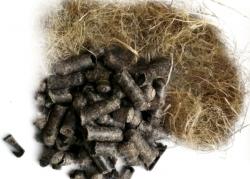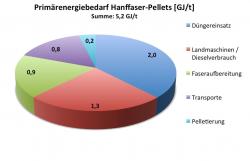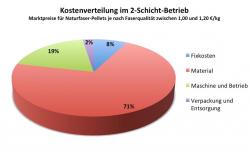Deutsche Version: www.bio-based.eu/news/nova-institut-durchbruch-beim-naturfaser-spritzgiessen/
The results of a project promoted by the DBU (Deutsche Bundesstiftung Umwelt), entitled “Development of industrial scale natural fibre pellet production using natural fibres to reinforce bioplastics in injection moulding and extrusion techniques”(ref. no. 27717-34) has generated significant interest within the industry: At the final event of the project 21st of May 2012 in Cologne (Germany) compounders, injection moulders, extruders and users from the plastics and automobile industries have expressed great interest in the hemp fibre pellets. Production and optimisation of the natural fibre pellets to resolve the problem of dosing natural fibres in plastic industry processing was achieved by project partner BaFa (Malsch, Germany).
The extensive range of trials by industry partners FKuR (Willich, Germany, www.fkur.com), H.Hiendl (Bogen, Germany, www.hiendl.de), Linotech (Waldenburg, Germany, www.linotech.de) as well as by the Fraunhofer WKI (Braunschweig, Germany, www.wki.fraunhofer.de), which were evaluated by the Bremen technical university of applied sciences in Germany (www.bionik.hs-bremen.de), showed that natural fibre pellets can not only be accurately dispensed but also blend well and evenly into the melt.

Prof. Dr. Jörg Müssig (HS Bremen, Bionik) and his team tested the properties of the hemp fibres before and after pelletisation, within the granulate and in the end product, as well as checking the mechanical values of test specimens and end products. It was only in this way that the project could ensure a progressive improvement in the natural fibre pellets.
Generally natural fibres bring more mechanical strength and rigidity to a plastic material. The infeed of natural fibres in form of optimized pellets brings further advantages, like a more homogenous distribution of the fibres, lower fibre damage and thus more intact and long fibres. Fibre shortening mainly occurs during the compounding step and not during pelletisation. Overall it was shown: The higher the fibre content and the better the quality of the applied fibre, the better the properties of the compound material.
Project leader Michael Carus of the nova-Institute (www.nova-institute.eu) expressed his satisfaction: “At last the bottle-neck presented by natural fibre infeed has been overcome. Now even companies with relatively little experience can dose natural fibres in pellet form. The pellets are already firm enough to resist the stresses of transport and storage, and soft enough to blend well into the melt.”
The producer, BaFa, offers pure natural fibre pellets as well as pellets that during pelletisation have been blended with up to 40% of a plastic such as PP or PLA, as well as having additives included if required by the customer. A surprising result of the project is, that pellets made from 60% natural fibre and 40% PP were able to be fed directly into the extruder without previous compounding, which saves a significant level of cost and process energy.
The nova-Institute tested the pellets with regard to the process energy used and with regard to their anticipated market price.
Ecology
The need of primary energy for the production of hemp fibre pellets is with its 5.2 GJ/t rather low compared to other materials. Typical plastics usually need ten times as much. Also interesting is, that the process step of the pelletisation only requires 0.2 GJ/t (4%). The biggest share is needed for fertilizer (38%) followed by farm machinery (25%) and the fibre processing (17%). Pesticides are usually not required when cultivating hemp; in other agricultural products they constitute a relevant share of the energy need.

This means for the application of the hemp fibre pellets: the energy need for the production of hemp fibre pellets is only marginally higher than that for the production of the hemp fibres. Thus, with regard to ecology, the application of the pellets gets the “green light”. It also has to be considered that technical effort in order to feed unpelletized hemp fibres also requires further energy which might even shift the balance to the pellets’ favour. In case the pellets are additionally mixed with plastics or additives already in the pelletisation step, later process steps may become obsolete.
Economy
Here it was seen that the market prices depend up to about 70% on the material cost (hemp fibres and, where relevant, plastics with an even higher share). Depending on the composition, prices for natural fibre pellets lie between 1.00 and 1.20 €/kg, which for most companies would be an attractive price as a solution to their infeed problems.

Bernd Frank, managing director of BaFa GmbH, has been enjoying a lively level of interest since these results were made public. The pelletisation plant is already running at a high rate to produce natural fibre pellets to customer requirements, with and without plastics or additives.
The comprehensive report on the project, including a range of process details and material tests of all project partners, are available for free download at (only in German language): www.bio-based.eu/technology
Download this press release as PDF file: 12-10-17_PR_Natural_fibre_pellets
Source
nova-Institut GmbH, press release, 2012-10-23
Supplier
BAFA Badische Naturfaseraufbereitung GmbH
Deutsche Bundesstiftung Umwelt (DBU)
FKuR Kunststoff GmbH
Fraunhofer-Institut für Holzforschung Wilhelm-Klauditz-Institut WKI
Hiendl Kunststofftechnik GmbH & Co. KG
Hochschule Bremen
LignoTech
nova-Institut GmbH
Share
Renewable Carbon News – Daily Newsletter
Subscribe to our daily email newsletter – the world's leading newsletter on renewable materials and chemicals










